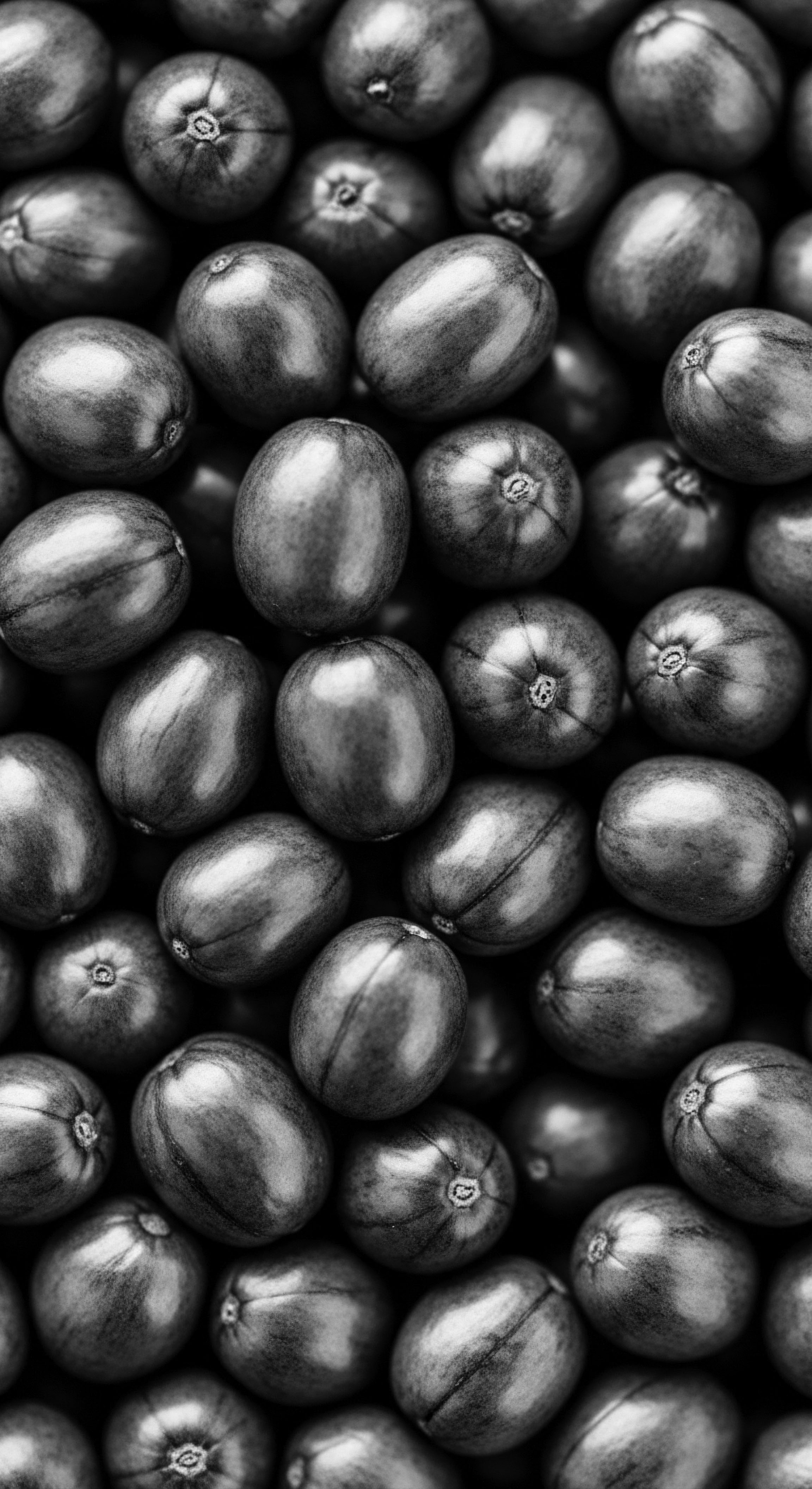
Roots
The vitality of our hair, particularly textured hair, has long been a reflection of life’s sustenance, a testament to the wisdom passed through generations. For Black and mixed-race communities, the connection between what nourished the body and how our hair presented itself is a profound, interwoven story, echoing ancestral practices and confronting historical disruptions. This exploration ventures into the dietary shifts that have shaped hair health, not as a mere scientific inquiry, but as a respectful journey into our collective heritage.

Ancestral Sustenance and Hair’s Beginnings
Before the forced displacements that fractured communities and altered lifeways, diets across diverse African lands were vibrant, drawing directly from the earth’s bounty. Indigenous food systems provided a full spectrum of macro and micronutrients, essential for robust physical well-being, which naturally extended to the health of hair. Consider the traditional West African diet, often rich in whole grains such as Fonio and Millet, alongside a vast array of leafy greens like Spinach and Amaranth, and protein sources such as legumes and fatty fish.
These foods supplied crucial building blocks ❉ proteins for keratin, the very structure of hair; iron for oxygen transport to follicles; and a host of vitamins and minerals. The daily rhythm of these ancestral foodways was not just about caloric intake; it was about communal practices, sacred reciprocity with the land, and a deep understanding of natural resources.
Ancestral diets, deeply connected to the earth, served as a fundamental wellspring for hair health, providing essential nutrients that sustained textured strands.
The ingenuity of these diets supported a hair texture that naturally insulates the brain from sun and heat, a protective adaptation to equatorial climates. African peoples utilized what was available, integrating plants like the Baobab, a rich source of vitamin C, and Acha, a grain recognized for its nutrient density, into their daily meals. The nourishment within these foods directly contributed to hair’s natural resilience, its capacity for growth, and its inherent luster. The relationship was symbiotic ❉ a healthy body, sustained by traditional foods, manifested in thriving hair.

The Shadow of Forced Migration and Nutritional Erosion
The Transatlantic Slave Trade initiated a brutal and profound shift in the dietary landscapes of millions. Stripped from their homelands, forcibly transported across vast oceans, enslaved Africans experienced an abrupt and devastating nutritional upheaval. The diets aboard slave ships were often meager, consisting primarily of highly salted meats, such as beef and pork, along with starchy carbohydrates like cassava, Indian corn, and yams.
Fresh fruits and vegetables, sources of vital vitamins and minerals, were scarce to non-existent due to storage challenges and unsanitary conditions, leading to severe nutritional deficiencies. This was not a subtle change; it was a radical dismantling of established foodways.
Upon arrival in the Americas, the dietary conditions remained harsh and restrictive. Enslaved populations were often relegated to consuming whatever rations were provided, typically low-quality staples. The ingenious adaptations to these meager provisions gave birth to what became known as “Soul Food,” a testament to resilience and creativity in the face of immense hardship.
However, these adaptations, born of necessity, frequently involved high-fat and high-sodium ingredients, deviating significantly from the plant-based, nutrient-dense diets of West Africa. This continuous cycle of deprivation, spanning generations, left an indelible mark on overall health, and by extension, on hair health.
| Aspect of Diet Staple Foods |
| Pre-Colonial African Diet Millet, fonio, yams, diverse leafy greens, legumes, wild game, fatty fish |
| Enslavement Era Rations Cornmeal, salted pork, salted beef, molasses, limited beans, cassava |
| Aspect of Diet Nutrient Density |
| Pre-Colonial African Diet High in vitamins, minerals, diverse proteins, healthy fats |
| Enslavement Era Rations Low, prone to deficiencies in vitamins (especially C, A), iron, protein |
| Aspect of Diet Food Preparation |
| Pre-Colonial African Diet Often fresh, fermented, varied cooking methods |
| Enslavement Era Rations Simple, aimed at preservation for transport, often high in sodium |
| Aspect of Diet Access to Fresh Produce |
| Pre-Colonial African Diet Seasonal, abundant variety |
| Enslavement Era Rations Severely restricted, almost non-existent during Middle Passage |
| Aspect of Diet The forced transition from traditional, land-sourced sustenance to meager provisions initiated a lasting nutritional deficit impacting hair health. |

A Biological Lens on Hair’s Response
Hair, composed primarily of a protein called Keratin, is an eloquent indicator of internal health. Its growth depends upon a steady supply of specific nutrients. When the body faces a deficit, vital organs receive priority, and hair often signals the first signs of deprivation. Protein deficiencies can lead to weakened strands, breakage, and stunted growth.
A lack of iron can impede oxygen delivery to hair follicles, a common cause of hair loss. Similarly, insufficient zinc can affect the growth and repair of hair follicle tissues, while deficiencies in B vitamins, particularly Biotin, compromise keratin production.
The shift from diverse, nutrient-rich diets to monotonous, inadequate fare directly impacted the very biology of textured hair. Generations accustomed to hair supported by robust internal systems suddenly faced conditions that undermined its structure and vitality. This nutritional stress contributed to changes in hair texture, strength, and overall health, leaving a lasting legacy that many still contend with today.

Ritual
Hair care rituals within Black and mixed-race heritage are not isolated acts of vanity; they are profound expressions of identity, community, and ancestral knowledge. These practices, often passed down from hand to hand, from elder to youth, traditionally entwined deeply with the dietary wisdom of the community. Understanding the impact of dietary shifts on hair health requires acknowledging how these changes disrupted not only the body’s internal nourishment but also the very external care rituals and the ingredients that sustained them.

Nourishment Beyond the Plate
For centuries, the foods that sustained communities also served as the basis for external hair care. Oils pressed from indigenous plants, such as Shea Butter, Palm Oil, and Marula Oil, which were consumed for their nutritional benefits, were simultaneously applied to hair for moisture, protection, and sheen. These were often food-grade ingredients, reflecting an integrated understanding of well-being where internal and external nourishment were inseparable.
The application of these butters and oils was a ritual in itself, a moment of connection, often accompanied by storytelling and shared wisdom. The natural oils mimicked the scalp’s sebum, offering deeper hydration and reinforcing the hair shaft.
Consider the use of Ghee, a clarified butter, in Ethiopian hair care traditions. This edible product, valued for its richness, also found its place in rituals for hair sustenance. Similarly, traditional African black soap, made from plant ash and oils, cleaned hair without stripping essential nutrients, containing vitamins A and E that feed nourishment to the scalp. The distinction between food and medicine, or between internal and external care, was often fluid, guided by a holistic approach that recognized the interconnectedness of all living things.

How Did Enslavement Alter Hair Care Traditions?
The experience of enslavement systematically dismantled cultural practices, including hair care traditions. With limited access to traditional ingredients and tools, and often forced to shave their heads upon capture to prevent lice or as a dehumanizing act, enslaved individuals lost their means of maintaining ancestral hair customs. The rich history of elaborate styles, signifying tribal identity, marital status, or social standing, was brutally suppressed.
Survival necessitated adaptation. Accounts speak of enslaved people using what little was available to them for hair care, including bacon grease, kerosene, and even lye, demonstrating desperate measures to maintain hair that could not thrive on nutrient-deprived bodies or with proper tools. Sundays, often the only day of rest, became a time for communities to gather, braiding each other’s hair using scavenged fats like butter or goose grease. These acts, though a shadow of former practices, were vital in preserving a semblance of identity and communal connection.
The introduction of commercial hair products, particularly chemical straighteners, later became a significant dietary shift by proxy. The desire for “good hair,” a term often synonymous with straight, European-textured hair due to deeply ingrained colonial beauty standards, led many to harsh chemical treatments. While these were not dietary shifts in the direct sense, they illustrate a socio-cultural shift driven by historical trauma, where external beauty standards, often fueled by nutritional deficiencies that weakened natural hair, influenced choices that further compromised hair health.

A Legacy of Nutritional Disadvantage
The dietary shifts imposed by historical circumstances created a nutritional legacy that persists in many Black and mixed-race communities. The forced reliance on calorie-dense but nutrient-poor foods contributed to a cycle of nutritional disparity. For instance, the high prevalence of vitamin D deficiency among African Americans, often linked to melanin’s blocking of UVB radiation in higher latitudes, is exacerbated by dietary gaps and a historical lack of access to diverse, nutrient-rich foods.
This particular deficiency can contribute to hair thinning and reduced density. Similarly, higher rates of iron deficiency anemia due to dietary gaps and other factors are common among Black women, directly affecting hair growth and maintenance.
The enduring influence of colonial food systems and post-slavery dietary shifts has created a nutritional gradient, impacting hair health across the African diaspora.
The historical displacement from ancestral food systems, coupled with ongoing challenges like food deserts and the prevalence of processed foods in modern diets, continues to shape the nutritional intake within these communities. This historical context provides a deep foundation for understanding present-day hair health concerns.

Relay
The journey of textured hair health, shaped by dietary landscapes, continues to unfold in our contemporary world, bearing the deep imprints of historical shifts. As we navigate current nutritional environments, the echoes of ancestral wisdom call us to a more mindful approach, recognizing the profound interplay between what we consume and the vitality of our strands. This understanding moves beyond simple dietary advice, reaching into the complex socio-economic and cultural factors that define the modern food experience for Black and mixed-race individuals.

Modern Dietary Complexities and Their Hair Manifestations
In the post-colonial era, globalization and urbanization brought new dietary patterns, often characterized by increased access to processed foods, refined sugars, and unhealthy fats. These shifts represent a departure from the traditional, whole-food diets that historically nourished communities. Such dietary changes can lead to systemic inflammation, hormonal imbalances, and nutrient deficiencies, all of which compromise hair health. For instance, diets high in sugar and refined carbohydrates can trigger insulin spikes and inflammation, potentially disrupting the hair growth cycle and contributing to hair loss.
A significant challenge lies in the concept of the “nutrition transition,” where populations move from traditional diets to those characterized by caloric excess and high intake of fats and processed animal products. For African Americans and Black populations in the United Kingdom, this transition has been linked to increased prevalence of obesity, type 2 diabetes, hypertension, and coronary heart disease—conditions that speak to broader systemic health impacts that often correlate with hair health decline.
Consider the prevalence of certain deficiencies. Studies indicate that nearly half of Black women experience some form of hair loss, with nutrient deficiencies, stress, and anemia being recognized contributing factors. For example, Iron Deficiency Anemia is common, impacting hair growth and shedding, and is often linked to dietary gaps.
Similarly, low levels of Vitamin D, which many Black women experience due to reduced synthesis in darker skin tones and dietary factors, are associated with hair thinning and reduced density. This evidence underscores how historical and contemporary dietary shifts continue to shape the very fabric of textured hair.

Reclaiming Ancestral Foodways and Science’s Affirmation
The path to revitalizing hair health in Black and mixed-race heritage often circles back to the wisdom embedded in ancestral foodways. Modern nutritional science increasingly validates the benefits of traditional diets, highlighting the significance of whole, unprocessed foods. Fatty fish, rich in Omega-3 Fatty Acids, aid in scalp health and circulation, while legumes provide protein, iron, and zinc—all essential for hair growth. Leafy greens offer a spectrum of vitamins crucial for collagen production and sebum regulation.
The current movement towards natural hair care, which encourages embracing texture and reducing reliance on harsh chemicals, also aligns with a renewed appreciation for holistic wellness that includes diet. This often involves a conscious return to food practices that sustained earlier generations, modified for modern accessibility.
A conscious return to ancestral foodways, affirmed by modern nutritional science, offers a powerful route to revitalizing textured hair health.
For instance, the cultivation of indigenous African foods, such as Baobab and Acha, can address not only food security but also nutritional needs, providing vitamins and minerals vital for hair. This deliberate choice supports not only individual health but also strengthens cultural ties and resilience within communities.
- Omega-3 Fatty Acids ❉ Found in fatty fish, walnuts, and flaxseeds, these lipids hydrate the scalp and hair.
- Iron ❉ Essential for oxygen transport to follicles, present in leafy greens, lean meats, and beans.
- Zinc ❉ Plays a role in tissue repair and hair follicle function, found in beans and nuts.
- Vitamins A, C, E ❉ Antioxidants that protect hair follicles, promote collagen production, and support sebum creation; abundant in colorful fruits and vegetables.
- Biotin (Vitamin B7) ❉ Supports keratin production for hair structure, available in nuts and eggs.

What Role Do Contemporary Food Systems Play in Hair Health Disparities?
The structure of modern food systems, particularly in Western societies, contributes disproportionately to health disparities in Black and mixed-race communities, which then impact hair health. Food deserts, areas with limited access to affordable, nutritious food, often exist in historically marginalized neighborhoods. This lack of access to fresh produce forces reliance on convenience stores that stock highly processed, nutrient-poor options. These dietary patterns, a direct consequence of systemic inequities, contribute to chronic health conditions and nutrient deficiencies that weaken hair.
The marketing of unhealthy foods also targets these communities, further entrenching dietary habits that compromise well-being. This complex interplay of historical disadvantage, current economic realities, and pervasive marketing creates a challenging environment for maintaining optimal dietary practices necessary for hair vitality. Addressing hair health, therefore, means also addressing systemic issues of food access and equity.

Can Reconnecting with Traditional Practices Reinforce Hair Resilience?
Reconnecting with traditional food and hair care practices serves as a potent act of reclamation and self-determination for textured hair. This is not about romanticizing the past, but about extracting enduring wisdom and adapting it to contemporary life. The deliberate choice to prioritize nutrient-dense whole foods, to source ingredients with care, and to integrate these into personal and communal routines, offers a powerful counter-narrative to centuries of deprivation.
The understanding of hair’s unique structure within Black and mixed-race heritage, its propensity for dryness and breakage, makes internal nourishment all the more crucial. When the body is adequately supplied with essential vitamins, minerals, and proteins, hair cells, being the second fastest dividing cells in the body, can thrive. This internal strength supports the hair’s natural resilience, allowing textured strands to better withstand environmental stressors and styling practices. This mindful approach, informed by both ancestral knowledge and contemporary science, cultivates a profound connection to the body’s inner workings and its outward expressions, including the crown of textured hair.

Reflection
The story of textured hair, its health intricately linked to dietary shifts, is a profound testament to resilience and adaptation across Black and mixed-race heritage. From the vibrant, nutrient-rich landscapes of ancestral Africa to the stark deprivations of forced migration, and into the complexities of modern food systems, each dietary alteration has left an indelible mark upon the strands. This journey underscores that our hair is not merely a collection of fibers; it is a living archive, a visible chronicle of ancestral experiences, sustenance, and survival.
As we honor the wisdom of those who came before us, who made sustenance from scarcity and sustained beauty in the face of hardship, we find powerful lessons for our own wellness. The legacy aspects of dietary shifts, from nutrient deficiencies to the quest for holistic nourishment, compel us to view textured hair care not as a trend, but as a continuous dialogue with our past, a celebration of enduring strength, and a vibrant path toward future well-being for every strand.

References
- Byrd, A. & Tharps, L. (2001). Hair Story ❉ Untangling the Roots of Black Hair in America. St. Martin’s Press.
- Carney, J. A. & Rosomoff, R. N. (2011). In the Shadow of Slavery ❉ Africa’s Botanical Legacy in the Atlantic World. University of California Press.
- Guo, E. L. & Katta, R. (2017). Diet and hair loss ❉ effects of nutrient deficiency and supplement use. Dermatologic Practical & Conceptual, 7(1), 1-10.
- Okonkwo, S. K. (2008). Nutritional consequences of the African diaspora. Annual Review of Nutrition, 21, 47-71.
- Sivasothy, A. D. (2011). The Science of Black Hair ❉ A Comprehensive Guide to Textured Hair Care. Sivasothy Hair Care Publications.
- Slone Epidemiology Center. (2016). Hair Loss in African American Women. Boston University School of Public Health.
